Russian aircraft carrier off the coast of Africa
The main world aggressor keeps at least 10 aircraft-carrying ships in its Navy. And the Pentagon is doing everything to prevent the use of aircraft carriers in combat conditions.
For decades, the Forestalls, Nimitzes and Kitty Hawks have demonstrated the ultimate dimensions and reference performance for ships in their class. An impressive "support group" of supply ships and escorts was formed for each unit. On the decks of aircraft carriers - the most advanced aircraft for solving any problem. At attention - trained crews. But when war happened somewhere, aircraft carriers freeze at the docks of Norfolk and San Diego.
Where "Nimitz" and "Kitty Hawks" were used, their involvement was so limited that at times it looked just ridiculous.
The important thing is not to win but to take part
Seeking out the "importance" of floating airfields in Operation Desert Storm is as absurd as talking about Australia's key contribution to the defeat of fascism. Forgetting to mention the Soviet-German front. The analogy, I think, is clear here.
The air offensive in the winter of 1991 was almost entirely the merit of the US Air Force. Of those who have fulfilled over 80% of sorties. With or without aircraft carriers, this war would have ended with the same result.
Or, in your opinion, much has changed in the NATO bombing of Yugoslavia, when the aircraft carrier Roosevelt appeared in the sea? He arrived promptly, on the 12th day after the start of the war. We wouldn't have finished without him!
Does anyone doubt that the US airborne units could not cope with the highland defenders of Grenada without the help of the 330-meter AB Independence?
On the results of the military campaign of "Kennedy" and "Independence" to the shores of Lebanon (1984), supporters of the "aircraft carrier fleet”Prefer not to remember at all.
Someone can cite a case when, over the past half century, aircraft carrier groups arrived the fastest in the zone of the outbreak of conflict? And such a surgical intervention would play a decisive role?
You will not find such examples.
Aircraft carrier and deck theme aviation arouses great interest, as if an unthinkable superweapon is being discussed. Without which some opportunities will be missed or an important military event may not take place.
So, the real combat experience of the "probable enemy" Navy shows a completely opposite picture. Those with dozens of aircraft carriers cannot show when they really came in handy.
All of the above examples are “nailing with a microscope”. Aircraft carriers were brought in, because the ships built I had to use it somewhere.
If the Armed Forces of the USSR / Russia had acted in the place of the Americans in these conflicts, they would have achieved similar results on time. Without any floating airfields. Because the experience of the enemy says that they were simply not needed there.
The public and specialists are vying with each other to impose on the Russian Navy the useless weapon... Describing with delight the work of steam catapults and aerofinishers. Only they cannot agree on a combat use in any way. It gets to the point of absurdity: experts, in an attempt to prove the significance of their idea, begin to invent completely naive scenarios.
Sea battle for offshore
"And what should we do then, how to save our money?" - such a question was raised in the article "Several questions to the opponents of aircraft carriers", in which the author A. Timokhin investigated the problem of protecting the Russian economic presence in Africa. And all over it turned out that there was no way to do without aircraft carriers.
Wait! Hundreds of billions of rubles have been invested in the economies of various African countries. At the same time, the allocated funds for the rearmament of the Navy do not allow even thinking about building a ship with a rank higher than a frigate. It doesn't work that way. And here you should not think about aircraft carriers off the beaches of Zanzibar. There are even more substantial threats.
(news 2019)
(TASS report, October 2019)
The last amount would be enough to modernize five Orlan heavy nuclear cruisers at once. But...
Why “feed this Africa” again?
In a commercial bank, a similar "touching story”Would be the subject of an investigation. Which will reveal the illegal actions of the management of the credit department. The scheme is as simple as day. In collusion with the "borrowers", managers appropriate the funds issued to themselves in the form of "kickbacks." Asocial elements, in whose name the loan is issued, receive an agreed percentage. And the bank, over and over again, has to write off the arisen debt due to the insanity of the "debtors".
At this point, the investigation of foreign economic activity at the Russia-Africa forum should be stopped. All matches are random. Our article is about something else entirely.
We would like to thank Alexander Timokhin for the fascinating combat fantasy with aircraft carriers off the Ivory Coast. But it should be noted that dropping bombs from deck attack aircraft on the heads of innocent Papuans is too cruel. We are totally against it. How do the leaders of Tumba-yumba know where the money is?
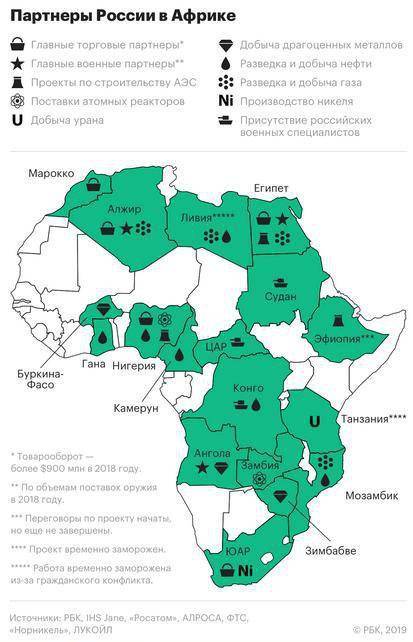
Infographics: RBC
For reference: in 2018, trade with Africa accounted for 2,5% of the total trade turnover. The lion's share, slightly more than a percent, is Egypt, slightly less than a percent - Algeria. Except for Egypt and Algeria, which are major buyers of Russian grain and weapons, all other countries for Russia are close to zero in terms of foreign trade.
It is clear that the problem of protecting "investments" in Africa is entirely far-fetched and has nothing to do with reality. But are other scenarios possible when there is an urgent need for aircraft carriers?
Examples from real conflicts
Cases related to the period of the Second World War are incorrect in modern conditions. Eighty years ago, piston aircraft had negligible speeds and a combat radius.
The raid on Taranto (1940) and bombing strikes on French ships in Casablanca (1942) were carried out from the decks of aircraft carriers, because the Swordfish "whatnot" and the Dontless dive bombers were afraid to fly the extra 100 miles. It was critical for them.
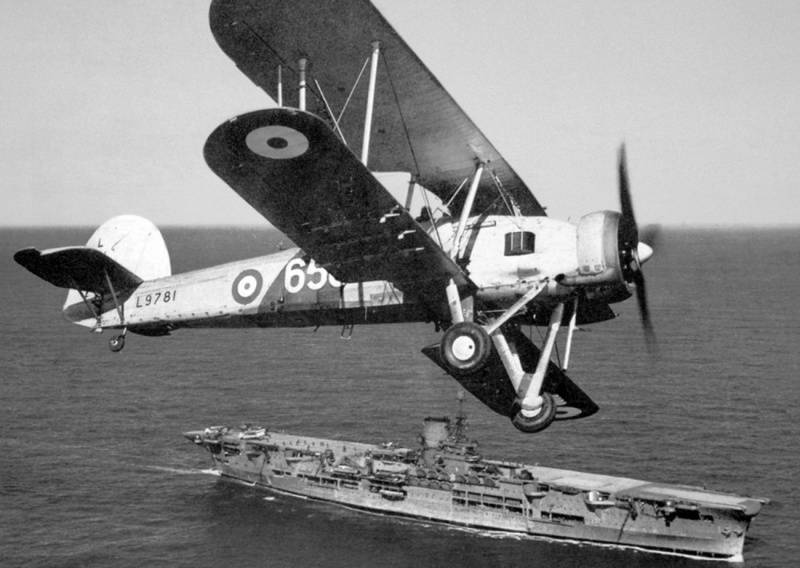
After 45 years, F-111 aircraft, having risen from British bases, in one night covered thousands of kilometers over the Bay of Biscay, along the coasts of France, Spain and Portugal. Then they turned east over Gibraltar, in order to pass at low altitude over the Sahara, to go to the Libyan capital. F-111 bombed and returned back along the same route, showing the real capabilities of combat aviation of the 80s (Operation Eldorado, 1986).
Why did they drive tactical bombers from Great Britain when two aircraft carriers with a full wing were located off the coast of Libya? Trained or wanted to save money? In any case, this indicates that such an operation could have been carried out without the participation of carrier-based aircraft.
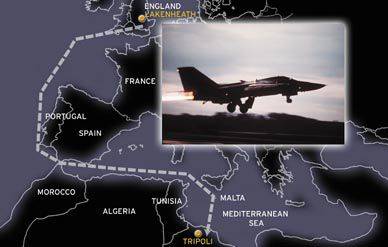
Проведение shock operations has long ceased to require the presence of air bases located near the combat zone. In this situation, the main advantage of the aircraft carrier - a mobile airfield, is depreciated. The practicality and effectiveness of weapons come first. Obviously, even the wealthy Yankees, accustomed to violent excesses, have questions about the practicality and efficiency of carrier-based aircraft.
Due to the extremely small number and deplorable technical condition, the experience of deck aviation in other countries can be neglected here. A Thai aircraft carrier with a penthouse for the royal family, or the Syrian campaign "Kuznetsov" disorganized in all respects. From the same series - the ever-troubled French "Charles de Gaulle".
Notable, status "toys" in the role of yachts for the top management of the fleet.
The distance from the base can be key only when providing continuous air cover for ground forces and naval groups. But, as history shows, since the end of World War II, no one else has erected "defensive perimeters" on atolls in the open ocean. And he did not strive to conduct hostilities where there was nothing but heavy impacts of waves on the side of the ship.
The 1982 Falklands conflict remained a unique example. One can describe for a long time the bizarre format of that "modern" war, in which Argentina had only five anti-ship missiles for the entire theater of operations.
We will confine ourselves to the fact that Russia, like most countries of the world, in principle, does not have territorial possessions in the other hemisphere. No contested or undisputed territories. Or other reasons to engage in a fierce battle with the participation of aircraft carrier groups. Against all who encroach on our sacred lands in Somalia and Easter Island.
The essence of economic "interests" somewhere in Africa was outlined a little higher. Another time, suggest using carrier-based aircraft to bombard offshore areas.
Figures and Facts
I have repeatedly had the honor to quote these figures. Achievements of American AUGs in local wars of the second half of the XX - early XXI centuries. So, with your permission:
War in Libya (2011). A narrow "strip" of land along the coast of the warm sea is ideal conditions for carrier-based aircraft. And ... not a single Nimitz came to greet Colonel Gaddafi. On the other hand, the US and NATO aircraft performed 26 thousand sorties, operating from air bases on the Greek islands, from Sicily and from airfields in Central Europe.
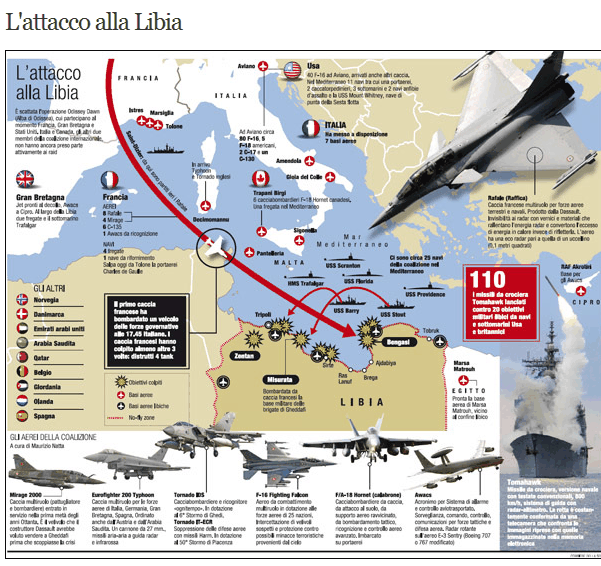
The beginning of the war in Afghanistan (2001). A story from the series "The Sixth Fleet off the Coast of Mongolia". But carrier-based aircraft were indeed used over the Afghan mountains and desert.
The duration of sorties from air bases located on the territory of the Persian Gulf countries, as well as from aircraft carriers in the Arabian Sea, reached 9-10 hours. The extreme duration was determined not only by the flight time, but by the tactics of using multi-role fighters. Duty couples, to the eyeballs loaded with bombs and weapons, patrolled for hours over the mountains, periodically refueling and attacking targets at requests from the ground.
To fly from aircraft carriers to Afghanistan was no closer than from ground airfields in the UAE. Therefore, under these conditions, carrier-based aircraft could not have any noticeable advantage over ground-based aircraft.
The fighting qualities of aircraft carriers, apparently, turned out to be so valuable and irreplaceable that the Kitty Hawk, located in that area, was transformed from a formidable aircraft carrier into a floating base and a "hotel" for special forces.
The deployment of military aircraft at the Karshi-Khanabad airbase in neighboring Uzbekistan was considered unjustified for various reasons. In Uzbekistan, there were only US Air Force combat support planes and transport and attack helicopters.
About a month later, the Americans recaptured the Kandahar airfield from the Taliban. And the real combat work of the Air Force began.
Yugoslavia (1999). Air strikes on Serbian territory were carried out by American aircraft deployed at air bases in many European countries.
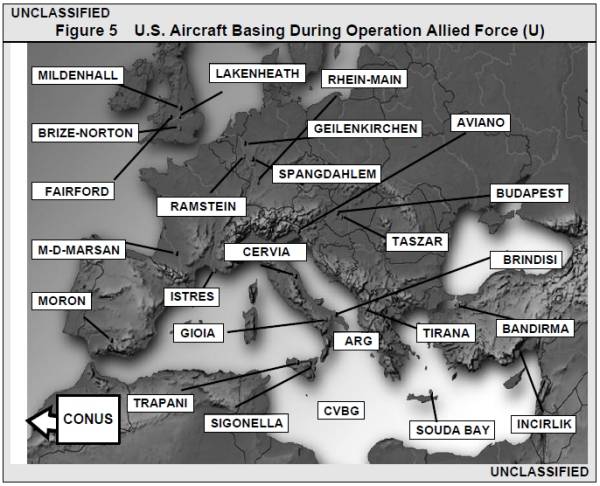
The war in the center of Europe did not require naval airfields. Therefore, it is not surprising that the US aircraft carrier fleet, represented by the only Roosevelt, was in no hurry to enter the combat zone.
The Roosevelt came to have the big and beautiful ship featured on the news. And the admirals were not left without their favorite medals.
Desert Storm (1991). The Gulf War was the largest campaign since 1945. Thousands tanks, half a million soldiers. On the background on such a scale the presence of several additional airfields, even floating ones, could not have a significant effect. Real indicators are less than 1/5 of all combat missions of the coalition.
It is noteworthy that the huge aircraft carrier forces that the United States had (14 AB units) did not even make an attempt to prevent the invasion of Iraqi armies into Kuwait. And they were inactive for the next six months, while Iraq pulled together forces and erected fortifications on the border, preparing for the inevitable war.
Here is the real price for all "fairy tales" about prompt reaction and "projection of force", the favorite arguments of the proponents of floating airfields.
Six of the oldest units were allocated to participate in the operation (including the Midway, built in 1945). Which were placed as far as possible from Kuwait - in the Arabian and even in the Mediterranean seas. Any incident with damage to aircraft carriers could have a big impact in public circles, so they were "floated" away. The coalition command needed beautiful statistics without losses.
Of course, no one entrusted the blinded Hornets with the bombardment of important and protected objects. Command posts of the air defense sectors, a command and control center in Al-Talji, power plants, a nuclear complex in Al-Tuwaita, pumping stations for filling ditches and canals with burning oil. Only Air Force squadrons were involved in such missions, including the use of stealth aircraft.
This is once again about the importance of carrier-based aircraft in that war.
Finally, if the Americans needed to place additional aircraft on the coast, equal in number to the air wings of six AB, then there were all the possibilities for this. Free up space on the airfields by sending back part of the obsolete and incapacitated aircraft of the coalition allies. Which stood without taking an active part in the war.
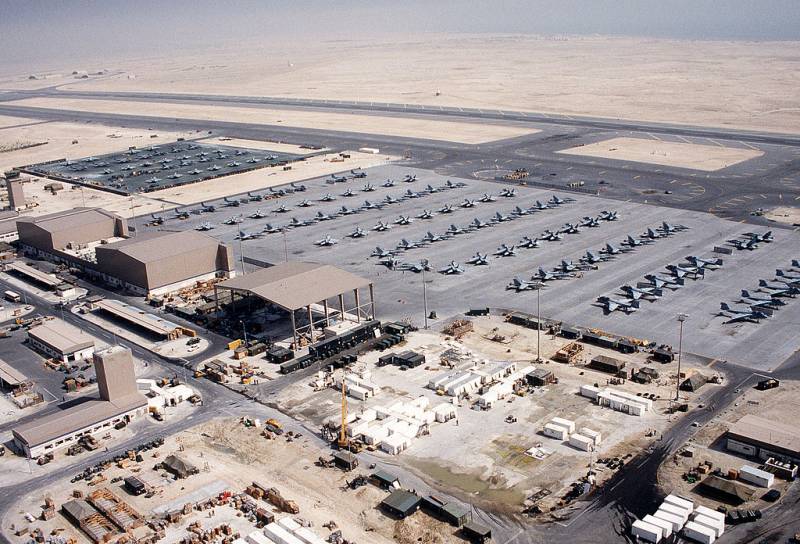
Multipurpose fighters "Hornet" and bombers A-6 "Intruder"
at the Sheikh Isa airbase in the Persian Gulf (1991)
The situation in the course of the Iraqi war (2003) differed only in a more modest scale of hostilities. Anyone who, for whatever reason, needed to bomb Iraq, Syria or Lebanon, managed to solve this task with the forces of the traditional air force.
Since the middle of the twentieth century, the United States has had a huge number of bases in the oil-producing countries of the Middle East. The army contingent is on duty on the coast, nondescript ships and boats patrol the adjacent bays. What are the carrier groups?
Which aircraft carrier was next to the Stark frigate hit by an Iraqi missile (hot 1988, "tanker war")? Near the frigate were only "old galoshes": the command ship "La Salle" and the destroyer "Kunz". AWACS "Sentry" hung in the air, and fighters from the Saudi airbase did not react, because their own "ally" fired at the Americans.
Just as the Soviet Navy carried out trawling and successfully escorted tankers through the troubled waters of the bay, without any help from first-rank aircraft carriers. In one of the "hottest" regions of the planet!
The battle of the aircraft carrier "Enterprise" with Iranian oil platforms is a clowning and the notorious "hammering nails with a microscope." The admirals are missing the new medals. Operation Praying Mantis (1988).
If the Enterprise was not nearby, the elderly missile cruiser Wainwright and the frigate Roberts would have shot Iranian corvettes just as they did in reality.
We are transported to Lebanon, on the calendar - 1984. Typical news from those places - the explosion of the embassy and the "response" is not known by whom. At that time, the enemy chose the position of the Syrian army in the Bekaa Valley.
The US Navy allocated aircraft carriers Kennedy and Independence, from which a dozen stormtroopers took off. The first and only air raid ended with the loss of two aircraft. Then the farce began. The ancient battleship New Jersey was driven to the shore and the valley was plowed up with 406-mm guns. Apparently, the Americans found it more effective and easier to use such an unusual and forgotten technique.
Invasion of Panama in 1989. There ... the fleet, in general, did not take part. It was a classic airborne operation. The A-7 Corsair deck shooter seen in the sky actually belonged to the forces of the National Guard.
As follows from all the above examples, from the very beginning of the 1980s to the present, there has not been a single case when the participation (or absence) of aircraft carriers in any way affected the course of hostilities.
We have to turn to an earlier era of the 1960s and 1970s. The main argument of all supporters of aircraft carriers is the Vietnam War.
This war happened too long ago
Over half a century ago. Citing Vietnam as an example, experts without the slightest doubt project the experience of that war onto the conflicts of the XNUMXst century. As if they might have something in common.
Nobody noticed that the rules and restrictions that were in force for aviation in that era look different now? The normal takeoff weight of the A-4 Skyhawk, the main attack aircraft of the US Navy, was three times less than that of the modern F-35. Just like the Su-35 is three times heavier than the MiG-21.
Even such a large fighter for its time as the twin-engine Phantom (20 tons) now seems undersized compared to the Raptors and the F-15E.
As in the case of WWII aircraft or the massive debut of jet aircraft in the skies of Korea, all this is a distant past. And if the subsonic Skyhawk piloted by McCain could not stay in the air for more than 3 hours, what does this have to do with modern combat aircraft of 4-5 generations?
The most interesting thing is that under the conditions of Vietnam, aircraft carriers did little to reduce the flight time or the convenience of using aviation. At one glance at the map, it becomes clear that flying from air bases or aircraft carriers to the combat zone was about the same. For obvious reasons, the area of combat maneuvering of aircraft carriers ("Yankee Station") was located in the open sea, hundreds of kilometers from the dangerous coast from which missiles were flying.
If we talk about the most advantageous bases of aviation, then the least distant from the combat zone were considered to be air bases on the territory of South Vietnam. For example, Danang, just a few tens of kilometers from the line of contact with the enemy.
On closer inspection, the Vietnam War appears to be an unexpectedly large and intense conflict. Three times more bombs fell on the territory of a small country than on Germany during the Second World War. And the losses of US aircraft were estimated at 10 thousand units. All this definitely hints that it would be impossible to wage such a war with carrier-based aircraft.
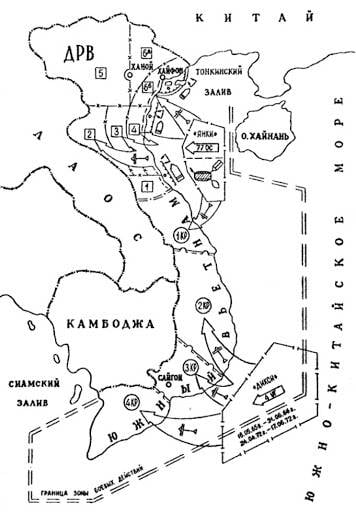
Domestic military experts draw up diagrams, which always indicate the areas of combat maneuvering of US aircraft carriers and do not say anything about the actions of the Air Force. Hence the false impression is created that the AB were the main participants in the war.
What our analysts attach importance to is very different from what the Americans themselves show. The following illustrations show the locations of major air bases and the routes of air tankers. And everything immediately falls into place.
The war was "dragged" by the US Air Force aircraft. Operating from airfields in Thailand (Korat, Green Hill, Chang Mai, Takli - only 28 places). And from air bases in the controlled territory of South Vietnam (the largest and most famous are Danang, Cam Ranh).
On the example of Vietnam, we did not see the main thing. Indispensable qualities of mobile aerodromes, which ensured the actions of aviation in the absence of places for basing on the coast. In fact, there were plenty of air bases in that region.
Of course, flying from the shore is not as beautiful and romantic as soaring over the waves to the deafening whistle of catapults! Well. Welcome to reality.
Finale
At the very end of the earth, during the Falklands Conflict, Britain has an ally to talk about. The worst enemy of the Argentine dictator Galtieri, the Chilean leader Augusto Pinochet.
Not wanting the "dispute between the two bald men over the comb" to turn into something serious, the British abandoned the deployment of combat aircraft at Chilean airfields, leaving only reconnaissance aircraft there. At the same time, the Chilean army began a series of provocative maneuvers on the border, drawing on half of the Argentine armed forces. What they could - they helped.
Returning to "securing the economic presence" somewhere in Africa. It never happened that a serious power had a mighty fleet and interests on another continent, but it was not revealed by a number of allies and assistants. Those who were ready to provide access to their airbases, ports, roads and military facilities for the "carrot" or simply out of burning hatred for their neighbors.
Often, they were not even asked, but simply presented with a fact.
An attentive reader may ask a question about the "Eldorado Canyon". The answer is - what kind of scoundrels do you have to be so that your antics scare off even the most loyal associates? Another beating of Libya seemed too much to the Europeans, and they closed their airspace. Everyone except the British. But that was 1986, so US tactical aircraft flew over Europe without any problems.
Allies anytime, anywhere. With the unrestrained growth of the characteristics of jet aircraft. It is for these reasons that the presence of aircraft carriers in local wars began to look so useless. And supporters of the aircraft carrier fleet are now struggling to find an area of application for their "idols", attracting everything here. Local wars, open confrontation with NATO fleets and even nuclear war.
Finally decide! The ship is built for specific tasks. And you, friends, have to invent tasks in order to justify the existence of your favorite aircraft carrier.
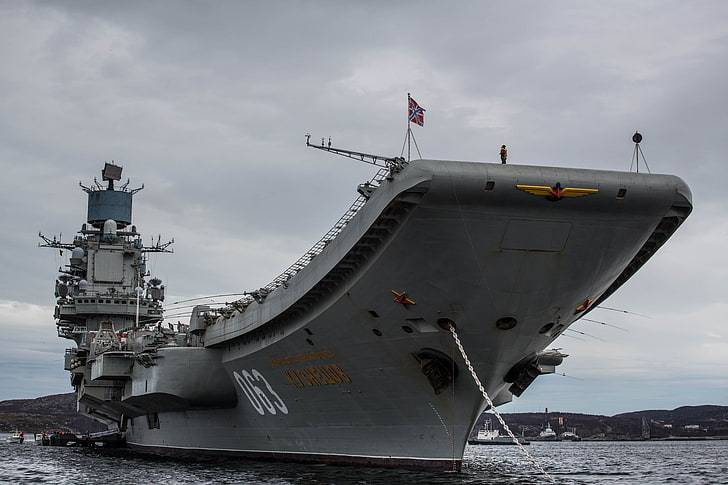
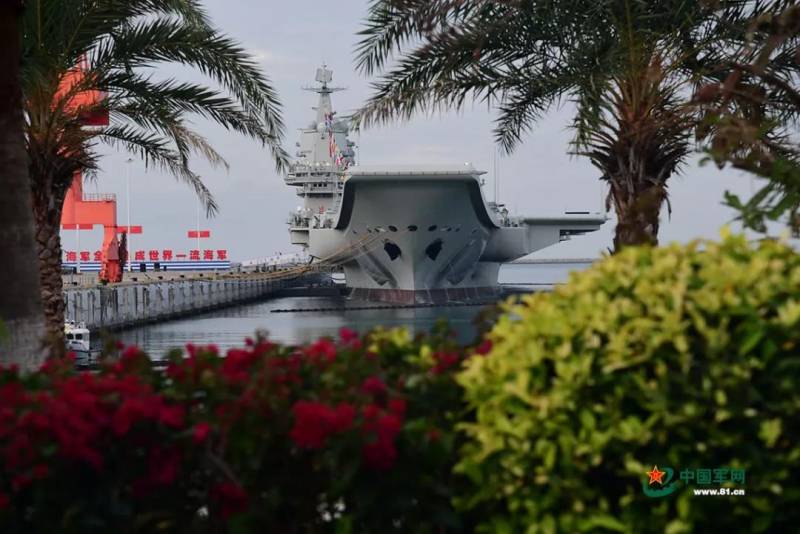
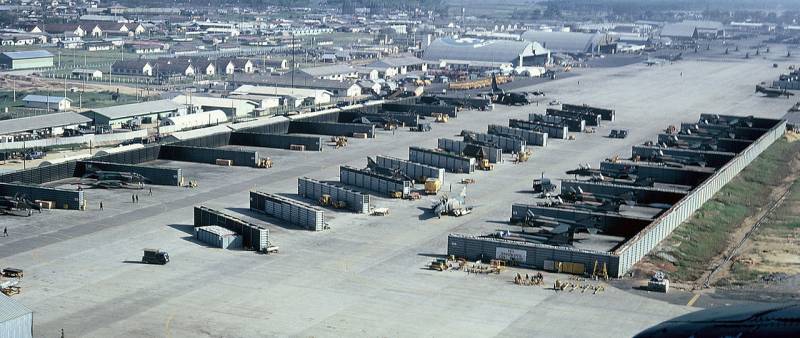
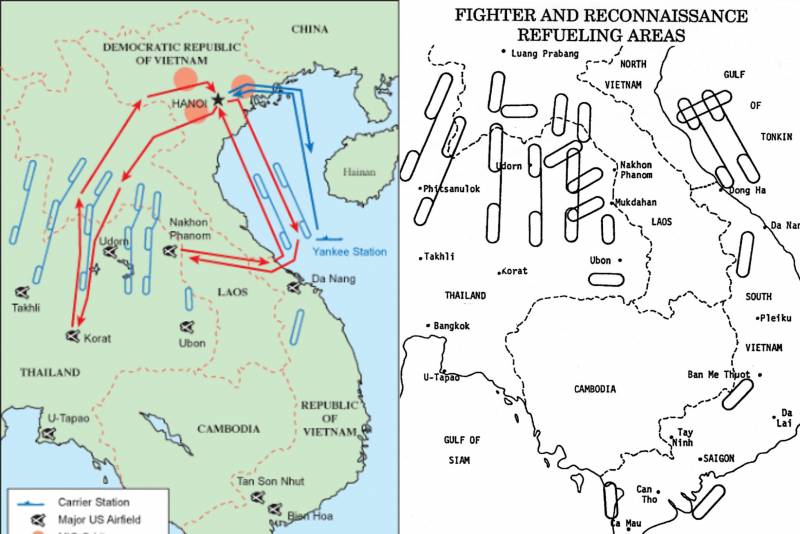
Information